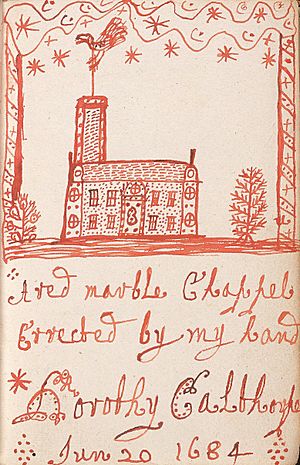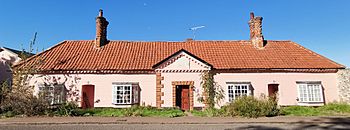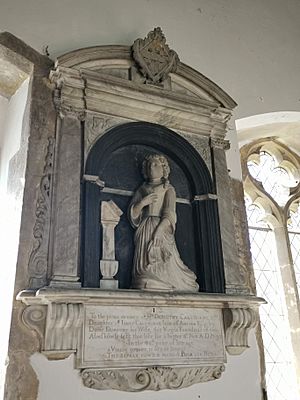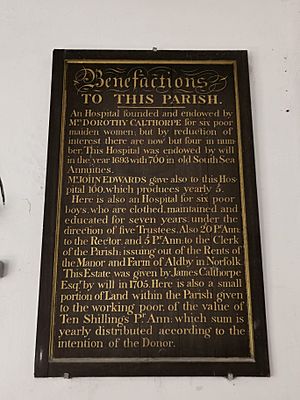Dorothy Calthorpe facts for kids
Quick facts for kids
Dorothy Calthorpe
|
|
|---|---|
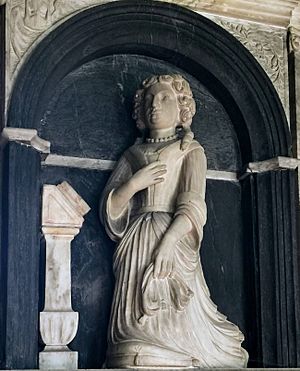
Dorothy Calthorpe as depicted on the monument to her in Ampton Church
|
|
| Born | 28 December 1648 Ampton |
| Died | 8 November 1693 Ampton |
| Notable works | "A Castell in the aire, or the pallace of the man in the moone" and "Discription of the Garden of Edden" |
| Relatives |
|
Dorothy Calthorpe (1648-1693) was a kind person who helped others (a philanthropist). She was also a writer, famous for a special handwritten book. This book contained her poems, a story about love and adventure (a prose romance), and two religious stories.
Contents
Dorothy Calthorpe's Early Life
Dorothy Calthorpe was born in Ampton, Suffolk, England. Her birthday was December 28, 1648. Her parents were James Calthorpe and Dorothy Reynolds.
Her father, James, was a "Roundhead." This was a name for people who supported the Parliament during the English Civil War. He was a very important person in Suffolk. In 1656, he was the High Sheriff of Suffolk, which was like a chief officer for the county. He even received a special honor from Oliver Cromwell, who was the leader of England at that time.
Dorothy lived her whole life in the village of Ampton. She never got married.
Dorothy Calthorpe's Writings
Dorothy Calthorpe wrote a special book by hand. It had many different kinds of stories and poems. One part was a story about her own family, but she used made-up names. The book also had three poems and two religious stories. These stories had spiritual and political ideas.
Two of her most famous works were "A Castell in the Aire or the Pallace of the Man in the Moon" and "A Discription of the Garden of Edden." She started writing this book around 1672 and finished it in 1684. This was during a time in England called the Exclusion Crisis. This was a political fight about who would be the next king. Dorothy's writings suggest she supported the king's side.
Even though her book had many different types of writing, they all shared common ideas. Dorothy often wrote about being a good Christian. She also wrote about being responsible with money, family, and relationships. These ideas were also shown in her charitable actions, which she planned in her will.
Her handwritten book includes:
- "Philismena to Philander": A poem with 40 lines.
- "Philander to Philismena": Another poem, 62 lines long.
- "In commendations of a country Life it being so innocent": A poem about how great country life is.
- "A Discription of the Garden of Edden": A creative story in prose.
- "A Short History of the Life and Death of Sr Ceasor Dappefer": A prose story about her family, finished in 1677.
- "A Castell in the aire or the pallace of the man in the moon": A religious story in prose, like a dream journey.
The first page of her book also has a drawing of a small church. It says, "A red marble Chappel Errected by my hand Dorothy Calthorpe Jun 20 1684." This shows that her book was not just a place for her stories. It was also a way for her to show her strong religious feelings through writing.
How Dorothy Calthorpe's Book Was Found
Scholars found Dorothy Calthorpe's special handwritten book in 2006. It was sold at an auction by Sotheby's. The book was bought by the Beinecke Rare Book & Manuscript Library at Yale University. It is now kept there for people to study.
"A Castell in the aire or the pallace of the man in the moon"
In this story, the writer pretends to be a "pilgrim." A pilgrim is someone who travels to a holy place. She uses "Jacob's Ladder" to "climb the sky." She wants to explore the "territories of the princes of the air." It's like a fantasy travel story.
At first, her journey seems to be about old Greek and Roman myths. She visits "the province of the man in the moon." Then she goes to "Charon's boat," which takes her to a snowy mountain. The story mixes old myths with Christian ideas about heaven.
Eventually, she reaches "gilded gates" and "the Land of Promise." A "handsome youth" welcomes her and becomes her guide. The heavenly places in "A Castell in the Aire" are described as very grand and beautiful. They are like the fancy homes of rich people during the Renaissance. The rooms are "Lofty" (very tall) and decorated with gold and jewels.
However, the story soon becomes very Christian. Her guide tells her she is like Lucifer, who was sent out of heaven for being too proud. This happens when she looks down at Earth from heaven and wants to stay there forever. Instead, she is told to "humbly and patiently wait." She must do "good works" to earn her place in heaven. This is one of many lessons she learns about being humble and patient.
"A Castell in the Aire" is part of a long history of fantasy travel stories. These kinds of tales were popular in England in the 16th and 17th centuries. Writers like Thomas More changed these stories to fit their own country's ideas. In the 1630s, several books about traveling to the moon were published. These included Francis Godwin's "The Discovery of a World in the Moone" and John Wilkins' "The Man in the Moone." These books were influenced by new ideas about the sun being the center of our solar system.
Dorothy Calthorpe's Death and Gifts
Dorothy Calthorpe died on November 8, 1693. In her will, which she wrote on May 18, 1693, she left many gifts to help poor people in her area.
She left £1,000 to create a special fund for "almshouses" in Ampton. Almshouses are homes for poor or elderly people. Her plan was for six old widows or single women to live there. She also left another £100 to help build these houses. However, the money was not quite enough, so only four almshouses were built. They were finished in 1695.
Dorothy also gave £500 to the town of Bury St Edmunds. This money was used to help poor boys learn useful skills (handicrafts) by becoming apprentices. An apprentice learns a trade by working for a skilled person. Some of this money was used to buy houses in the town. In 1891, this gift was still providing money, about £73. This would be worth around £7,250 today.
Dorothy also left some of her own books in her will. She gave some to her relatives and some to the people who would live in the almshouses.
There is a marble monument to Dorothy Calthorpe in St Peter's Church in Ampton. It shows her kneeling by a book. It also has carvings that remind people about life and time, like a skull and an hourglass.
To the pious memory of Mis Dorothy Calthorpe 2.d Daughter of Iames Calthorpe later of Ampton Eſqß: by Dame Dorothy his Wife, this Virgin Foundreſs of the Almſhowſe left this life for a better 8th Nov: A.D. 1693
In the 45th year of her age. A Virgin votary is oft in Snares This safely vow'd & made ye Poor her Heirs
Today, the almshouses are a private home called Park Lodge. They are still a reminder of Dorothy Calthorpe's kindness and generosity.


